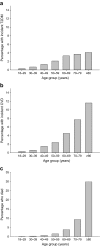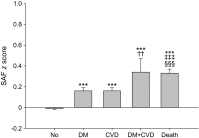Skin autofluorescence predicts incident type 2 diabetes, cardiovascular disease and mortality in the general population
- PMID: 30460578
- PMCID: PMC6323092
- DOI: 10.1007/s00125-018-4769-x
Skin autofluorescence predicts incident type 2 diabetes, cardiovascular disease and mortality in the general population
Abstract
Aims/hypothesis: Earlier studies have shown that skin autofluorescence measured with an AGE reader estimates the accumulation of AGEs in the skin, which increases with ageing and is associated with the metabolic syndrome and type 2 diabetes. In the present study, we examined whether the measurement of skin autofluorescence can predict 4 year risk of incident type 2 diabetes, cardiovascular disease (CVD) and mortality in the general population.
Methods: For this prospective analysis, we included 72,880 participants of the Dutch Lifelines Cohort Study, who underwent baseline investigations between 2007 and 2013, had validated baseline skin autofluorescence values available and were not known to have diabetes or CVD. Individuals were diagnosed with incident type 2 diabetes by self-report or by a fasting blood glucose ≥7.0 mmol/l or HbA1c ≥48 mmol/mol (≥6.5%) at follow-up. Participants were diagnosed as having incident CVD (myocardial infarction, coronary interventions, cerebrovascular accident, transient ischaemic attack, intermittent claudication or vascular surgery) by self-report. Mortality was ascertained using the Municipal Personal Records Database.
Results: After a median follow-up of 4 years (range 0.5-10 years), 1056 participants (1.4%) had developed type 2 diabetes, 1258 individuals (1.7%) were diagnosed with CVD, while 928 (1.3%) had died. Baseline skin autofluorescence was elevated in participants with incident type 2 diabetes and/or CVD and in those who had died (all p < 0.001), compared with individuals who survived and remained free of the two diseases. Skin autofluorescence predicted the development of type 2 diabetes, CVD and mortality, independent of several traditional risk factors, such as the metabolic syndrome, glucose and HbA1c.
Conclusions/interpretation: The non-invasive skin autofluorescence measurement is of clinical value for screening for future risk of type 2 diabetes, CVD and mortality, independent of glycaemic measures and the metabolic syndrome.
Keywords: Ageing; Cardiovascular; Diabetes; Mortality; Prediction; Skin autofluorescence.
Conflict of interest statement
RG and AJS are founders and shareholders in Diagnoptics Technologies (Groningen, the Netherlands), manufacturer of the AGE reader that was used in the present study. All other authors declare that there is no duality of interest associated with this manuscript.
Figures


Comment in
-
Skin autofluorescence predicts T2DM.Nat Rev Endocrinol. 2019 Feb;15(2):64. doi: 10.1038/s41574-018-0141-y. Nat Rev Endocrinol. 2019. PMID: 30531918 No abstract available.
References
Publication types
MeSH terms
Substances
LinkOut - more resources
Full Text Sources
Other Literature Sources
Medical
Miscellaneous

